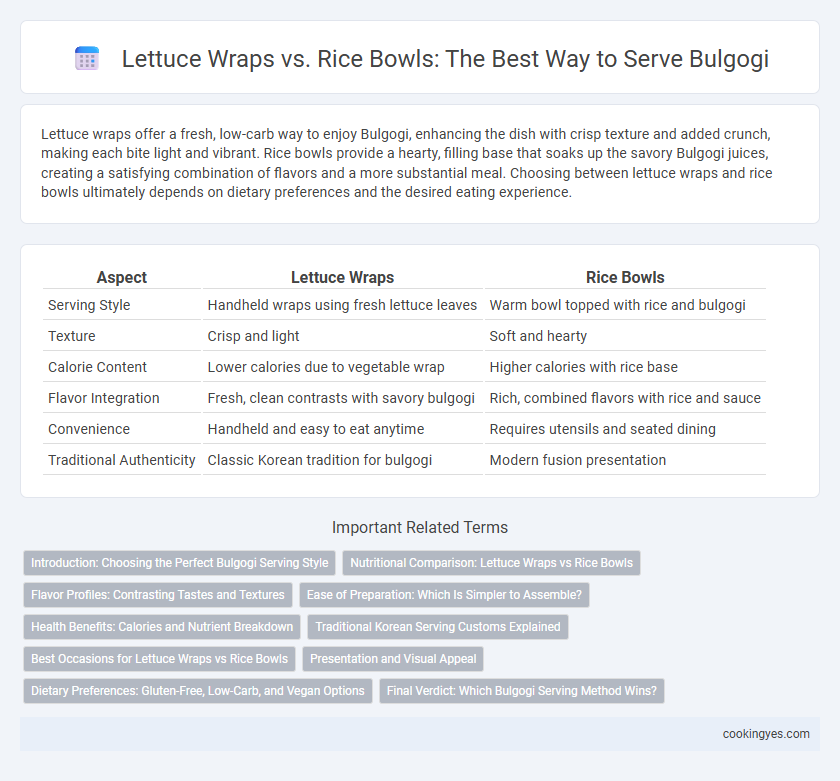Lettuce wraps offer a fresh, low-carb way to enjoy Bulgogi, enhancing the dish with crisp texture and added crunch, making each bite light and vibrant. Rice bowls provide a hearty, filling base that soaks up the savory Bulgogi juices, creating a satisfying combination of flavors and a more substantial meal. Choosing between lettuce wraps and rice bowls ultimately depends on dietary preferences and the desired eating experience.
Table of Comparison
| Aspect | Lettuce Wraps | Rice Bowls |
|---|---|---|
| Serving Style | Handheld wraps using fresh lettuce leaves | Warm bowl topped with rice and bulgogi |
| Texture | Crisp and light | Soft and hearty |
| Calorie Content | Lower calories due to vegetable wrap | Higher calories with rice base |
| Flavor Integration | Fresh, clean contrasts with savory bulgogi | Rich, combined flavors with rice and sauce |
| Convenience | Handheld and easy to eat anytime | Requires utensils and seated dining |
| Traditional Authenticity | Classic Korean tradition for bulgogi | Modern fusion presentation |
Introduction: Choosing the Perfect Bulgogi Serving Style
Lettuce wraps offer a fresh, low-carb option that highlights the savory flavors of Bulgogi while providing crisp texture and added crunch through fresh vegetables and dipping sauces. Rice bowls serve as a hearty, filling choice, combining tender marinated beef with steamed rice and often incorporating kimchi or pickled vegetables to balance savory and spicy notes. Selecting between lettuce wraps and rice bowls depends on desired taste experience, nutritional preference, and cultural dining style.
Nutritional Comparison: Lettuce Wraps vs Rice Bowls
Lettuce wraps offer a low-calorie, low-carb option for serving Bulgogi, making them ideal for those seeking to reduce carbohydrate intake and increase vegetable consumption. Rice bowls provide a higher energy source with complex carbohydrates essential for sustained fuel, along with fiber and B vitamins from brown rice varieties. Choosing lettuce wraps enhances vitamin K and antioxidant intake, while rice bowls support energy metabolism and satiety through their carbohydrate content.
Flavor Profiles: Contrasting Tastes and Textures
Lettuce wraps with Bulgogi offer a fresh, crunchy contrast that enhances the savory sweetness of marinated beef, while rice bowls provide a hearty, comforting base that absorbs the rich, umami flavors. The crispness of lettuce adds a refreshing bite, balancing the boldness of garlic and soy in Bulgogi, whereas the softness of steamed rice emphasizes the tender texture and caramelized notes. Choosing between wraps and bowls depends on a preference for light, crisp textures or warm, cohesive flavors in the Bulgogi experience.
Ease of Preparation: Which Is Simpler to Assemble?
Lettuce wraps require washing and drying fresh lettuce leaves, then layering thinly sliced Bulgogi with complementary toppings, making assembly quick and customizable. Rice bowls involve cooking rice to the right texture before adding Bulgogi and side ingredients, which can be more time-consuming but offers a more filling meal. Overall, lettuce wraps offer simpler, faster assembly with fewer cooking steps compared to rice bowls.
Health Benefits: Calories and Nutrient Breakdown
Lettuce wraps with Bulgogi are lower in calories and carbohydrates compared to rice bowls, making them a lighter, nutrient-dense option rich in fiber and vitamins like vitamin K and vitamin A. Rice bowls provide more energy from complex carbohydrates, essential for sustained fuel, and contain B vitamins and minerals such as magnesium that support metabolism. Choosing lettuce wraps helps reduce calorie intake while enhancing vegetable consumption, whereas rice bowls offer a balanced mix of protein and carbs suitable for energy replenishment.
Traditional Korean Serving Customs Explained
Traditional Korean serving customs for Bulgogi often emphasize lettuce wraps, or "ssam," where thinly sliced grilled beef is wrapped in fresh leafy greens with garlic, chili, and ssamjang sauce, enhancing each bite with balanced flavors and textures. Rice bowls, while popular globally, are a more modern adaptation that prioritize convenience and a heartier meal but lack the interactive and communal aspect central to traditional Korean dining. Lettuce wraps embody cultural values of sharing and customization, making them the preferred, authentic method for enjoying Bulgogi in Korea.
Best Occasions for Lettuce Wraps vs Rice Bowls
Lettuce wraps featuring Bulgogi are ideal for casual gatherings, light meals, and outdoor settings due to their freshness and ease of eating by hand. Rice bowls with Bulgogi suit more formal dinners, hearty meals, and colder weather, providing a warm and filling experience. Choosing between wraps and bowls depends on the occasion's formality, desired meal heaviness, and serving environment.
Presentation and Visual Appeal
Bulgogi served in lettuce wraps offers a vibrant, fresh presentation with bright green leaves providing a natural, crisp contrast to the rich, caramelized beef, enhancing visual appeal through layered textures and colors. Rice bowls showcase the bulgogi nestled among grains and often accompanied by colorful vegetables and garnishes, creating a hearty and visually balanced dish with appealing depth and variety. Both serving styles highlight Bulgogi's savory essence but differ in aesthetics: lettuce wraps emphasize freshness and lightness, while rice bowls emphasize warmth and fullness.
Dietary Preferences: Gluten-Free, Low-Carb, and Vegan Options
Lettuce wraps offer a gluten-free and low-carb alternative to traditional rice bowls for serving Bulgogi, allowing for a fresh, crunchy texture while accommodating dietary restrictions. Rice bowls provide a more filling option but are higher in carbohydrates and may contain gluten if soy sauce is not gluten-free. Vegan Bulgogi versions, often made with marinated mushrooms or tofu, pair well with either serving style, with lettuce wraps enhancing the low-carb appeal and rice bowls delivering more energy-dense nourishment.
Final Verdict: Which Bulgogi Serving Method Wins?
Lettuce wraps highlight Bulgogi's fresh, crunchy contrast and low-carb appeal, making them ideal for light, health-conscious meals. Rice bowls offer a hearty, satisfying base that complements the savory, marinated beef, providing a balanced, filling experience. The final verdict favors rice bowls for overall versatility and comfort, while lettuce wraps win for freshness and dietary flexibility.
Lettuce wraps vs Rice bowls for Bulgogi serving Infographic

 cookingyes.com
cookingyes.com